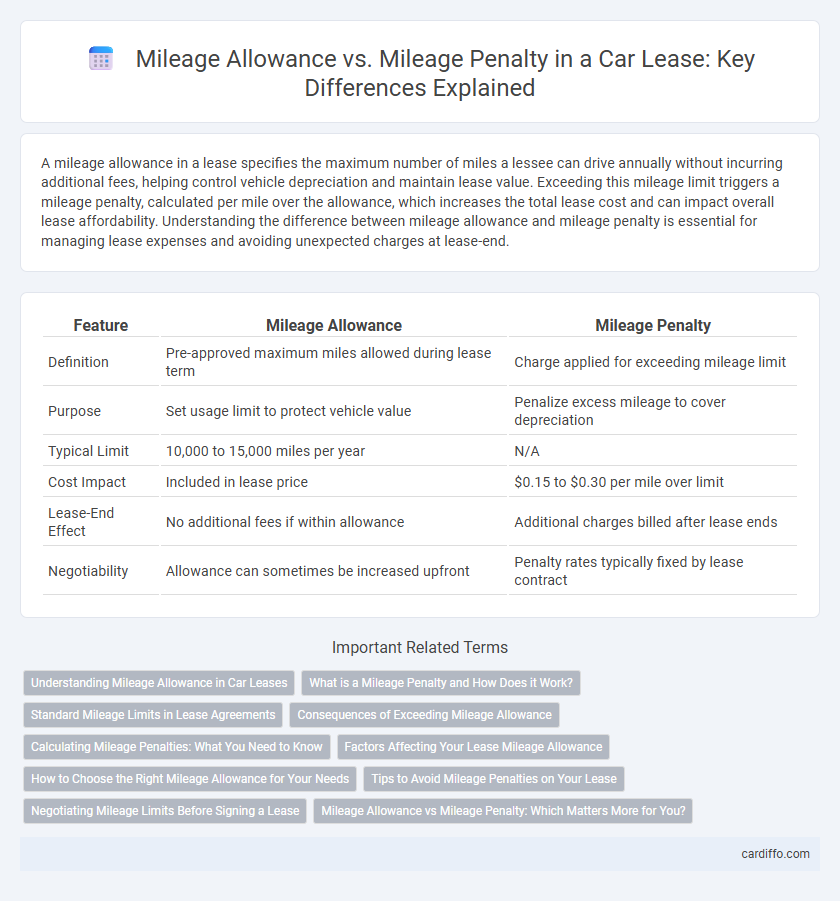A mileage allowance in a lease specifies the maximum number of miles a lessee can drive annually without incurring additional fees, helping control vehicle depreciation and maintain lease value. Exceeding this mileage limit triggers a mileage penalty, calculated per mile over the allowance, which increases the total lease cost and can impact overall lease affordability. Understanding the difference between mileage allowance and mileage penalty is essential for managing lease expenses and avoiding unexpected charges at lease-end.
Table of Comparison
| Feature | Mileage Allowance | Mileage Penalty |
|---|---|---|
| Definition | Pre-approved maximum miles allowed during lease term | Charge applied for exceeding mileage limit |
| Purpose | Set usage limit to protect vehicle value | Penalize excess mileage to cover depreciation |
| Typical Limit | 10,000 to 15,000 miles per year | N/A |
| Cost Impact | Included in lease price | $0.15 to $0.30 per mile over limit |
| Lease-End Effect | No additional fees if within allowance | Additional charges billed after lease ends |
| Negotiability | Allowance can sometimes be increased upfront | Penalty rates typically fixed by lease contract |
Understanding Mileage Allowance in Car Leases
Mileage allowance in car leases specifies the maximum number of miles a lessee can drive annually without incurring extra charges, typically ranging from 10,000 to 15,000 miles per year. Exceeding this mileage allowance triggers mileage penalties, calculated per mile, which can significantly increase lease costs. Understanding the mileage allowance is crucial for managing lease expenses and avoiding unexpected fees at the end of the lease term.
What is a Mileage Penalty and How Does it Work?
A mileage penalty is a fee charged when a lessee exceeds the agreed-upon mileage limit specified in a lease contract. This penalty is calculated based on the excess miles driven multiplied by a predetermined rate, often ranging from $0.15 to $0.30 per mile. Exceeding mileage limits can significantly increase lease-end costs, impacting the overall affordability of the lease agreement.
Standard Mileage Limits in Lease Agreements
Standard mileage limits in lease agreements typically range from 10,000 to 15,000 miles per year, defining the maximum allowable driving distance without incurring extra charges. Exceeding these limits results in a mileage penalty, often charged at rates between 15 to 25 cents per excess mile, increasing the total lease cost. Staying within the mileage allowance helps avoid additional fees and preserves the residual value of the leased vehicle.
Consequences of Exceeding Mileage Allowance
Exceeding the mileage allowance on a lease results in a mileage penalty calculated per mile over the limit, often significantly increasing the total lease cost. These penalties can accumulate quickly, affecting the lease-end financial obligations and potentially reducing the lessee's creditworthiness. Maintaining mileage within the allowance is crucial to avoid unexpected fees and preserve the lease's overall affordability.
Calculating Mileage Penalties: What You Need to Know
Calculating mileage penalties involves comparing the actual miles driven to the agreed-upon mileage allowance specified in the lease contract, with excess miles incurring a set per-mile charge. Accurately tracking and documenting mileage throughout the lease term ensures precise penalty assessments and prevents unexpected costs at lease-end. Knowing the exact mileage rate in your lease agreement helps estimate potential penalties and manage overall lease expenses effectively.
Factors Affecting Your Lease Mileage Allowance
Lease mileage allowance is influenced by factors such as the vehicle type, lease term length, and anticipated annual usage, which help determine the maximum miles permitted without extra charges. Higher mileage allowances often increase monthly payments, reflecting the expected depreciation and wear-and-tear costs associated with extensive driving. Understanding these factors ensures lessees can optimize their lease terms to balance cost-effectiveness and avoid mileage penalties.
How to Choose the Right Mileage Allowance for Your Needs
Selecting the right mileage allowance depends on your typical driving habits and lease term length to avoid excess mileage penalties that can increase costs significantly. Estimating annual mileage accurately helps balance monthly payments and potential overage fees, ensuring you pay only for the miles you truly need. Understanding lease terms and comparing mileage packages allows for a customized allowance that aligns with your lifestyle and prevents costly penalties at lease end.
Tips to Avoid Mileage Penalties on Your Lease
To avoid mileage penalties on your lease, carefully track your mileage using a reliable app or odometer readings and plan trips to stay within the agreed limit, typically between 10,000 to 15,000 miles per year. Consider negotiating a higher mileage allowance at the start of the lease if you anticipate driving more, as excess mileage fees can range from $0.15 to $0.30 per mile, significantly increasing lease-end costs. Monitoring mileage throughout the lease term allows adjustments in driving habits or early lease termination to prevent costly penalties and maintain lease compliance.
Negotiating Mileage Limits Before Signing a Lease
Negotiating mileage limits before signing a lease is crucial to avoid unexpected costs, as mileage allowances typically range from 10,000 to 15,000 miles per year, with penalties averaging 15 to 25 cents per additional mile. Setting realistic mileage limits aligned with your driving habits can prevent costly excess mileage fees that increase the total lease expense. Understanding these terms upfront empowers lessees to customize agreements, balancing monthly payments and mileage flexibility effectively.
Mileage Allowance vs Mileage Penalty: Which Matters More for You?
Mileage allowance defines the maximum distance you can drive a leased vehicle without incurring extra charges, typically ranging from 10,000 to 15,000 miles per year. Exceeding this limit results in a mileage penalty, often charged at 15 to 30 cents per additional mile, which can significantly increase your lease costs. Understanding your driving habits and comparing the cost impact of mileage allowance versus penalties helps determine which factor matters more for managing your lease budget effectively.
Mileage Allowance vs Mileage Penalty Infographic

 cardiffo.com
cardiffo.com